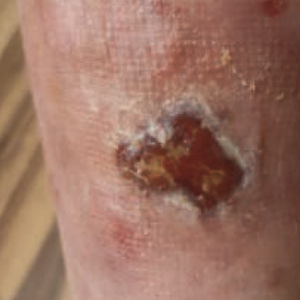Ustekinumab in the treatment of acute disseminated pyoderma gangrenosum in a patient with Crohn’s disease

All claims expressed in this article are solely those of the authors and do not necessarily represent those of their affiliated organizations, or those of the publisher, the editors and the reviewers. Any product that may be evaluated in this article or claim that may be made by its manufacturer is not guaranteed or endorsed by the publisher.
Authors
Pyoderma gangrenosum (PG) is an auto-inflammatory dermatosis characterized by lesions that often cause ulcers. We present a case of successful ustekinumab treatment for acute general PG in a 31-year-old woman with coexisting Crohn’s disease (CD). For a month, the patient suffered from skin ulcers, two of them deep and necrotic; a histopathological examination revealed PG. Treatment included: methylprednisolone, azathioprine, betamethasone, gentamicin and zincic ointments, antiseptic compresses, and adalimumab therapy. Due to resistance to the implemented treatment, the patient was enrolled in a clinical trial that included the administration of an anti-cytokines drug, ustekinumab. Subsequently, a significant reduction was observed in the severity of symptoms of PG with no relapse. The use of ustekinumab in patients with PG who have an inadequate response to current treatment or cannot receive first-line treatment can be considered. This applies especially to patients with accompanying autoimmune diseases such as CD.
How to Cite

This work is licensed under a Creative Commons Attribution-NonCommercial 4.0 International License.








